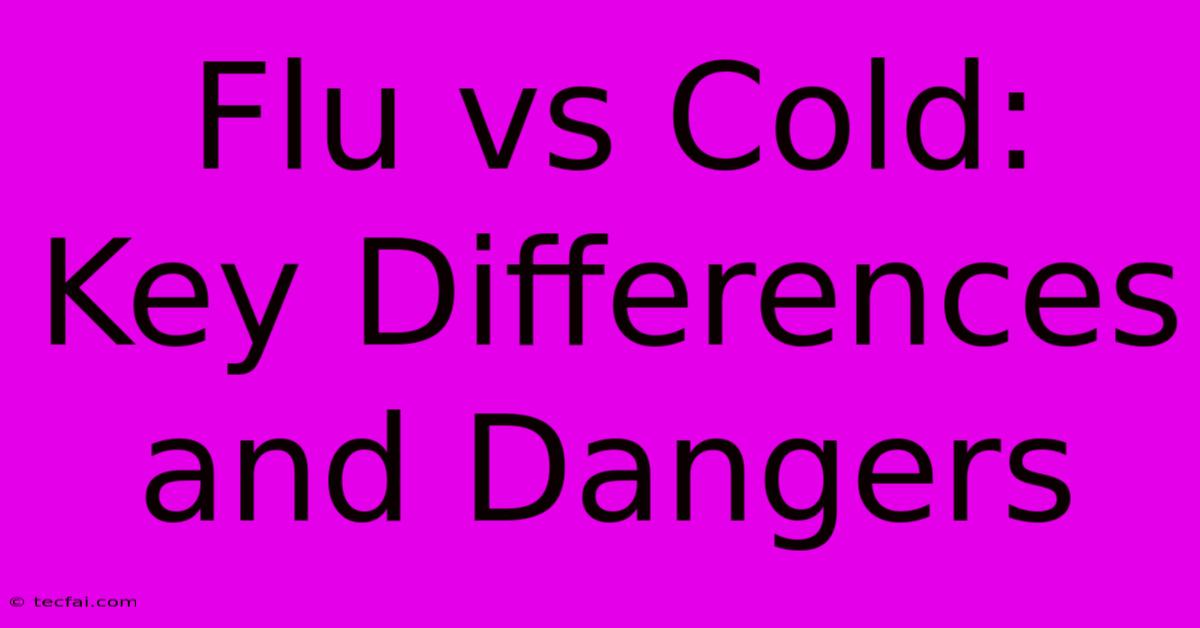Flu Vs Cold: Key Differences And Dangers

Discover more detailed and exciting information on our website. Click the link below to start your adventure: Visit Best Website tecfai.com. Don't miss out!
Table of Contents
Flu vs. Cold: Key Differences and Dangers
The common cold and the flu (influenza) are both respiratory illnesses, causing similar symptoms like coughing and sneezing. However, understanding the key differences between these two is crucial for appropriate treatment and preventing serious complications. This article will delve into the distinguishing features of the flu and the common cold, highlighting the potential dangers associated with each.
Understanding the Flu
Influenza, commonly known as the flu, is caused by influenza viruses. These viruses are highly contagious and spread easily through the air via coughs and sneezes, or by touching contaminated surfaces. The flu season typically runs from October to May in many parts of the world, although variations occur depending on geographical location.
Key Symptoms of the Flu:
- Sudden onset: Flu symptoms typically appear abruptly.
- High fever: Often exceeding 100°F (38°C).
- Body aches: Significant muscle and joint pain.
- Severe fatigue: Overwhelming tiredness and exhaustion.
- Cough: Usually dry and persistent.
- Sore throat: Can be painful and debilitating.
- Headache: Often intense.
- Chills: Feeling cold despite being in a warm environment.
Dangers of the Flu:
While many people recover from the flu without complications, it can pose serious health risks, especially for:
- Young children: Their immune systems are still developing.
- Older adults: Their immune systems may be weakened.
- Pregnant women: The flu can increase the risk of complications during pregnancy.
- People with chronic health conditions: Such as asthma, heart disease, or diabetes.
The flu can lead to severe complications like pneumonia, bronchitis, ear infections, and even death. Therefore, seeking medical attention promptly if you suspect you have the flu is critical. Vaccination is the best defense against the flu, especially for high-risk individuals.
Understanding the Common Cold
The common cold is a viral infection of the upper respiratory tract, usually caused by rhinoviruses. While less severe than the flu, it's highly contagious and easily spread through similar mechanisms.
Key Symptoms of the Common Cold:
- Gradual onset: Symptoms typically develop slowly over a few days.
- Low-grade fever: Fever, if present, is usually mild and doesn't exceed 100.4°F (38°C).
- Mild body aches: Muscle aches are less severe than those experienced with the flu.
- Runny nose: A common and often prominent symptom.
- Sore throat: Usually mild.
- Cough: Can range from mild to moderate.
- Congestion: Stuffy nose and sinuses.
Dangers of the Common Cold:
While generally not life-threatening, the common cold can lead to complications such as:
- Sinusitis: Infection of the sinuses.
- Ear infections: Particularly in young children.
- Bronchitis: Inflammation of the bronchi.
These complications are more likely to occur in individuals with weakened immune systems. While a cold usually resolves on its own within a week or two, managing symptoms with rest, fluids, and over-the-counter medications can help alleviate discomfort.
Flu vs. Cold: A Comparison Table
| Feature | Flu | Common Cold |
|---|---|---|
| Onset | Sudden | Gradual |
| Fever | High (often >100°F/38°C) | Low-grade (or none) |
| Body aches | Severe | Mild |
| Fatigue | Extreme | Moderate |
| Cough | Usually dry and persistent | Can be dry or productive with mucus |
| Runny nose | May be present, but less prominent | Usually prominent |
| Severity | More severe | Less severe |
| Complications | Pneumonia, bronchitis, etc. | Sinusitis, ear infections, bronchitis |
Conclusion
While both the flu and the common cold cause similar symptoms, the severity and potential dangers differ significantly. Understanding these differences is essential for seeking appropriate medical care and taking preventative measures. Remember, vaccination against the flu is a crucial step in minimizing the risk of severe complications and protecting public health. If you experience severe or worsening symptoms, consult a healthcare professional immediately.

Thank you for visiting our website wich cover about Flu Vs Cold: Key Differences And Dangers. We hope the information provided has been useful to you. Feel free to contact us if you have any questions or need further assistance. See you next time and dont miss to bookmark.
Featured Posts
-
Lapd Father Of Missing Woman Dead
Nov 26, 2024
-
Trump Jan 6 Case Dismissed
Nov 26, 2024
-
Farewell To Barbara Taylor Bradford
Nov 26, 2024
-
Hamas Rejects Hostage Deal Rumors
Nov 26, 2024
-
La Clippers Boston Celtics Injury Update
Nov 26, 2024
